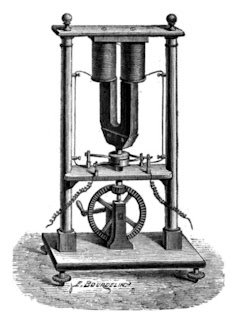The earliest cranked inductor was probably built by a French engineer named Antoine-Hippolyte Pixii. He built a simple dynamo based a description of Faraday's 1831 device. Faraday had mounted a copper disk on an axle and spun it between the poles of a magnet. This generated an electric current. In 1832 Pixii modified that so that the magnet was rotated by a hand crank and he positioned it such that its north and south poles passed over two pieces of iron wrapped with coiled wire. It's those coils of wire that are so important. Pixii even determined that each pole produced a separate pulse of current i.e. This was an AC device! Pixii had previously been hired by both Andre
Ampere and Claude Pouilett to build their own instruments. So this was not his first foray.
Joseph Saxton of Philadelphia built a unit based on the Pixii design. His first devices dates to 1832, but he had but the basic design to paper at least a year earlier. He reversed the mechanism instead spinning the horseshoe magnet and leaving the coils stationary. His went through several revisions, but the basic device was described in detail in his 1874 memoir read before the National Sciences Academy by none other than Joseph Henry.
This cranking and rotating of the magnet gets closer and closer to a dynamo. A is just an electrical generator that uses rotating coils of wire and magnets to convert mechanical rotation into electric current. It's output is governed by Faraday's law. That law is as follows: The EMF generated is proportional to the rate of change of the magnetic flux. That's exactly what Callan observed. The faster he could make and break the circuit, the greater the current output by his cranking. All this leaves me with one big question. How do we get from the 1836 "invention" of the induction coil to the 1856 "invention" of the induction coil?"Mr. Saxton fastened the U to a revolving axis passing through its crown, to which a rapid rotation could be given by means of a driving wheel and pulley. In order, however, to obtain manifestations of the induced currents produced in the copper-wire, the two ends of the coils were so soldered together, as to give a single current in one direction through the entire length of the coils. One of the remaining ends was then permanently soldered to a circular disk fastened concentrically to the revolving axis by an insulating collar, with its plane perpendicular to it. This plate dipped into a cup of mercury. The other end of the wire was soldered directly to the revolving shaft or axis."
In 1835 Edward Samuel Ritchie and Edmond Clarke were fighting it out over who made the better induction coil yet both were based on the work of Pixii. In 1838 Daniel Davis made a slightly modified machine based on the published accounts of Page and Sturgeon. Davis actually published a 72-page catalog filled with models of home electrical induction devices. These were presumably for the purpose of shocking oneself or ones friends and family for "medical" purposes or just the schadenfreude. In 1839 a German doctor named Christian Neef et De La Rive innovated a new make/break mechanism to increase output. It was a hammer break mechanism. It consisted of a spring contact that operated automatically to break the electrical circuit when displaced by the action of the electromagnet. William Sturgeon published the first English version of the Neef "repeater" in 1839. Interestingly Page credits the so-called Neef-Hammer to Prof James William McGauley. It then further states that Ruhmkorff stole McGauley's circuit breaker.
After all of that progress, there is still a 18-year gap still remaining between that last material improvement and Ruhmkorff "invention" of the induction coil. In truth Major improvements essentially stop before 1940. Even circuit breakers have little improvement until Foucault in 1856. Golding Bird made some minor refinements to McGauley's device in 1838. Ernst Neeff also gets a mention for an equally minor adjustment in 1839. In 1842 W.T. Henley proffered a coil that worked ran on a clock-work mechanism. But that mechanism was actually from Rev. F. Lockey. It was more of an amalgam than an invention. In 1842 Page was discharging electrical flashes in vacuum tubes and working on electric motors.
The reason that improvements stopped is that the device had been "perfected." It was fully functional. It was moving out of the lab and into commercial use. That's where it remained for almost 2 decades. By 1843 both Thomas Wright and Neef were boiling water with an induction coil. In the year 1850 Werner Siemens patented a dial telegraph and an alarm for it which used an automatic vibratory circuit breaker which also drew from McGauley's circuit breaker. All manner of devices were built, stocked shipped and sold: telegraphs, alarms, bells, buzzers, X-ray devices, electroshock.. all manner of consumer and medical devices used induction coils. All these products and services apparently awaited their retroactive post-Ruhmkorff invention.







No comments:
Post a Comment